Farming games enable players to drive authentic tractors in sophisticated simulators that replicate real agricultural environments. These games feature realistic driving mechanics and tractor controls that reflect the physics of actual machinery. Players can engage in crop management, navigate diverse terrains, and practice sustainable farming techniques. Leading simulators offer multiplayer options for cooperation, allowing players to share resources and strategies. Customization features empower users to design their farms according to personal preferences. Each game enhances player experience through immersive storytelling and community interactions. Explore further aspects of farming games to uncover deeper insights into their enthralling mechanics and features.
Key Takeaways
- Realistic tractor controls and physics enhance immersion, mimicking actual agricultural machinery operation in farming simulators.
- Dynamic weather systems and terrain challenges require strategic navigation and crop management for successful farming experiences.
- Multiplayer options foster community interactions, enabling cooperative gameplay and resource sharing among players.
- Customization features allow players to design their farm layout and select equipment tailored to their farming style.
- Educational elements promote sustainable practices, helping players understand modern agricultural methods and responsible farming techniques.
Popular Farming Game Features
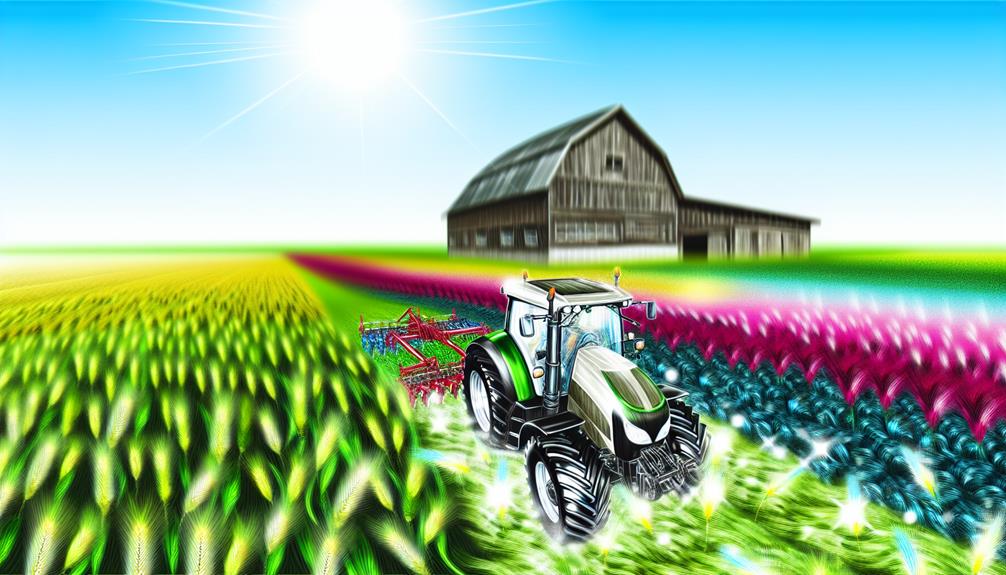
Frequently, popular farming games incorporate a variety of features that enhance player engagement and realism, making the simulation experience more immersive. These features often reflect current farming innovation trends and sustainable agriculture practices, ensuring that players not only enjoy the game but also gain insight into modern agricultural methods. For those interested in remote job opportunities, these games can also inspire entrepreneurial ideas related to agricultural services and products.
One prominent feature is the inclusion of realistic crop management systems, which require players to monitor soil health, weather conditions, and pest control. This fosters a deeper understanding of sustainable farming techniques, as players learn the importance of crop rotation and organic fertilization. Additionally, many games now offer dynamic weather systems that affect crop yields, simulating real-world agricultural challenges.
Another engaging aspect is the integration of farm machinery, where players can operate various vehicles and tools designed to mimic actual farming equipment. This hands-on approach enhances the learning experience, allowing players to appreciate the role of technology in modern farming.
Furthermore, multiplayer options encourage community interaction, fostering a sense of belonging as players collaborate on sustainable projects. Ultimately, these features not only entertain but also educate, cultivating a greater awareness of responsible farming practices among players.
Top Farming Simulators of 2023
The evolution of farming simulators in 2023 showcases a remarkable blend of innovation and realism, capturing the essence of modern agriculture. This year, leading titles have embraced the rich tapestry of farming history while integrating cutting-edge agricultural innovations. Players can engage in sustainable practices that reflect real-world farming challenges, from crop diversity to the complexities of farm economics. As seen in the gaming world, there's an increasing focus on immersive storytelling and character development, which enhances player engagement and investment in the farming experience the anticipated gaming landscape.
Top simulators such as *Farming Simulator 22* and *Hay Day* introduce players to intricate systems that simulate seasonal changes, allowing for a deeper understanding of crop cycles and their environmental impact. These games not only entertain but also educate, fostering awareness of rural development issues and the importance of responsible farming.
Moreover, the incorporation of community features encourages a sense of belonging among players, as they collaborate on projects and share resources. By simulating the realities of modern farming, these simulators provide an immersive experience that resonates with both seasoned farmers and newcomers alike. As virtual agriculture continues to expand, it's evident that the top farming simulators of 2023 are paving the way for a more sustainable and informed approach to farming.
Driving Mechanics in Farming Games
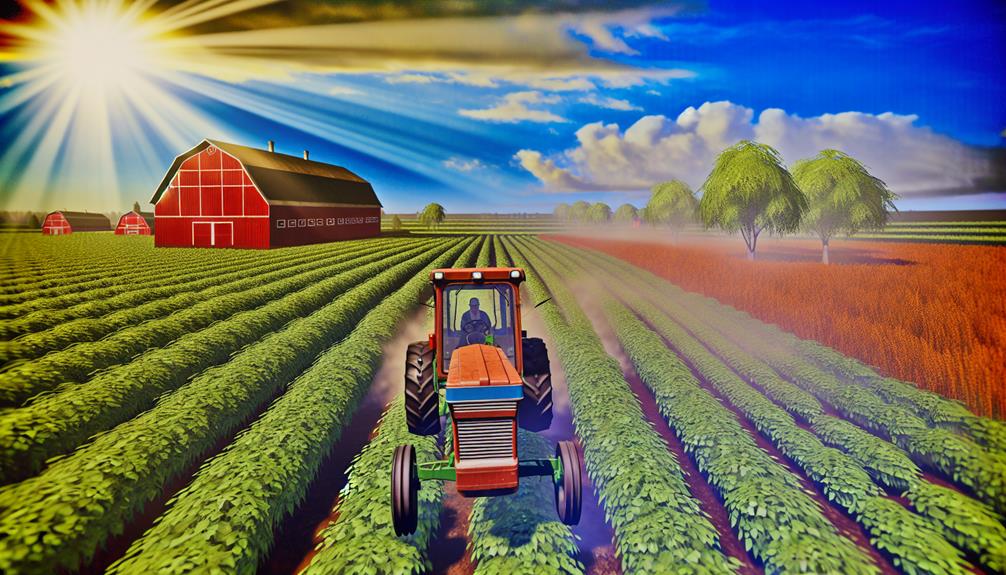
Driving mechanics in farming games play a vital role in enhancing the player's experience, particularly through realistic tractor controls that mimic the operation of actual agricultural machinery. To improve gameplay, players can also consider using personal peripherals that enhance their setup for better control and immersion. The challenge of traversing varied terrain further adds to the complexity, requiring players to adapt their driving techniques to manage slopes, mud, and obstacles effectively. This blend of realism and challenge not only immerses players in the farming experience but also reflects the intricacies of real-world farming operations.
Realistic Tractor Controls
In the domain of farming simulation games, the implementation of realistic tractor controls is essential for enhancing player immersion and engagement. These controls rely heavily on realistic physics, allowing players to experience the true weight and handling characteristics of various tractors. Successful equipment handling is contingent upon understanding driving techniques that reflect real-world scenarios, such as acceleration, braking, and turning dynamics.
Control sensitivity is another vital aspect, as it determines how responsive the tractor is to player inputs. A well-calibrated user interface can greatly improve the driving experience by providing essential information without overwhelming the player. Feedback mechanisms, such as haptic feedback and visual cues, further enrich this experience, giving players tangible sensations of their actions on the tractor.
To support players in mastering these controls, many games offer driving tutorials that guide them through the nuances of tractor operation. Additionally, tractor upgrades can enhance performance, allowing players to adapt their equipment to different farming tasks. By intertwining these elements, farming simulation games create an environment that fosters a sense of belonging, inviting players to cultivate their virtual farms with confidence and skill.
Terrain Navigation Challenges
While traversing varied terrain is a fundamental aspect of farming simulation games, overcoming the associated challenges requires a deep understanding of vehicle dynamics and environmental interactions. Players must traverse diverse terrain types, from muddy fields to rocky hills, each presenting unique obstacle traversal tasks. Mastering vehicle stability is vital for successful off-road driving, as seasonal changes and weather effects can markedly alter field conditions.
Key strategies for effective terrain traversal include:
- Terrain Mapping: Understanding the layout and characteristics of different landscapes to anticipate challenges.
- Elevation Challenges: Employing techniques to manage steep inclines and declines, ensuring safe and efficient movement.
- Pathfinding Strategies: Developing routes that optimize travel while minimizing risk during adverse conditions.
As players engage with realistic simulations, they learn to adapt their driving skills to meet the demands of shifting environments. Whether dealing with muddy tracks after a rainstorm or traversing rugged hills during harvest season, these challenges foster a sense of accomplishment and deep connection to the farming experience. The journey through diverse terrains not only enhances gameplay but also cultivates a community of dedicated simulation enthusiasts.
Crop Management Strategies
Effective crop management strategies are vital for maximizing yield and sustainability in agricultural practices. To achieve optimal results, farmers must implement crop rotation, which enhances soil fertility by alternating the types of crops grown, thereby reducing pest populations and nutrient depletion. This can be likened to exploring diverse regions in a simulated environment, where different terrains contribute to overall success. Integrated pest management is another key component, utilizing biological controls and targeted applications to minimize pest impact while safeguarding beneficial organisms.
Harvest timing is essential for yield enhancement; understanding the ideal moment to harvest can greatly influence the quality and quantity of produce. Additionally, staying informed about market trends allows farmers to select the most profitable crops, guaranteeing financial viability.
Sustainable practices such as cover cropping and reduced tillage not only improve soil health but also boost resilience against adverse weather impacts. Equipment maintenance is equally important, as well-maintained machinery guarantees efficient operations and minimizes downtime, contributing to overall productivity.
Livestock Care and Breeding
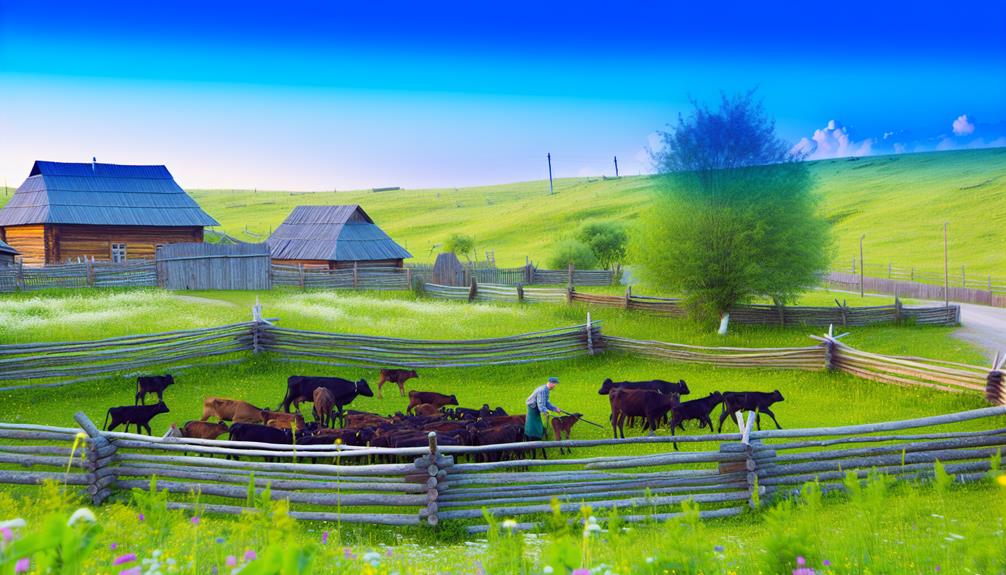
Successful agricultural practices extend beyond crop management to encompass livestock care and breeding, both of which play integral roles in farm productivity and sustainability. Effective animal husbandry guarantees that livestock are healthy and productive, while innovative breeding techniques enhance genetic diversity and species compatibility. These aspects are important for maintaining robust livestock populations, which in turn contribute to farm sustainability. Additionally, leveraging technology and educational resources can provide farmers with valuable insights into best practices for livestock management, as seen in essential tools for K-12 success. To achieve ideal livestock productivity, farmers should prioritize:
- Livestock Nutrition: Providing balanced diets that meet the specific needs of different species fosters growth and reproductive success.
- Veterinary Care: Regular health check-ups and vaccinations are necessary to prevent disease and promote overall well-being.
- Pasture Management: Rotational grazing and maintaining healthy pastures are significant for supporting animal welfare and guaranteeing sustainable feed sources.
Multiplayer Farming Experiences
Multiplayer farming experiences offer players the opportunity to engage in cooperative gameplay dynamics, where collaboration enhances productivity and efficiency on shared farms. Additionally, competitive farming challenges introduce an element of strategy and skill, encouraging players to optimize their resources against one another. These features not only foster community building but also enrich the overall gaming experience, making multiplayer farming simulations a vibrant aspect of the genre.
Cooperative Gameplay Dynamics
As players collaborate within the immersive environments of farming simulations, the dynamics of cooperative gameplay become essential in enhancing the overall experience. Engaging in cooperative missions fosters an environment where teamwork strategies are paramount. By utilizing communication tools effectively, players can coordinate their efforts to achieve shared goals, such as completing farm events or overcoming collective challenges.
The integration of role assignments allows each member to contribute uniquely, enhancing the sense of belonging within the farming community. In joint farming endeavors, players can partake in resource sharing, optimizing productivity while building alliances that deepen relationships.
Key elements of cooperative gameplay include:
- Teamwork Strategies: Develop structured approaches to maximize efficiency and success.
- Resource Sharing: Facilitate equitable access to tools and materials for all players.
- Alliance Building: Strengthen bonds through collaborative efforts, creating a supportive network.
Ultimately, the engagement in cooperative gameplay dynamics transforms the farming simulator experience, creating a vibrant community where players can cultivate not only virtual crops but also lasting friendships and connections.
Competitive Farming Challenges
Competitive farming challenges in multiplayer environments introduce a thrilling aspect to the farming simulator genre, where players can showcase their skills and strategies against one another. These challenges often encompass various formats, including competitive crop competitions, where players race against the clock to cultivate and harvest the highest yield of crops. Such competitions foster a sense of belonging, as players unite in their passion for farming while vying for top honors.
In addition to crop cultivation, tractor racing events add another layer of excitement. Participants can engage in adrenaline-pumping races across diverse terrains, testing their driving abilities and mastery of their equipment. Each event encourages players to refine their techniques, optimize their tractors, and develop unique strategies to gain an edge over competitors.
Community Building Features
Building a vibrant community within farming simulators enhances the multiplayer experience, fostering collaboration and camaraderie among players. Community building features are essential for creating an engaging environment that encourages players to connect and share their agricultural journeys.
Multiplayer interactions often include:
- Cooperative missions that require teamwork, enabling players to achieve common goals while strengthening bonds.
- Community events and seasonal festivals that promote social farming, allowing players to participate in themed activities, contests, and challenges that celebrate their collective achievements.
- Online marketplaces for resource sharing, where players can trade goods and materials, enhancing farm design and productivity.
Moreover, guild formations enable players to join like-minded individuals, providing a support network for sharing strategies and user-generated content. This interconnectedness transforms the gaming experience from solitary farming to a thriving ecosystem of player interactions. As players collaborate, they develop a sense of belonging that enriches their digital farming endeavors. By embracing these community-building features, farming simulators not only create a platform for agricultural creativity but also foster lasting friendships among players, making the virtual world feel like a true home.
Customization Options for Your Farm
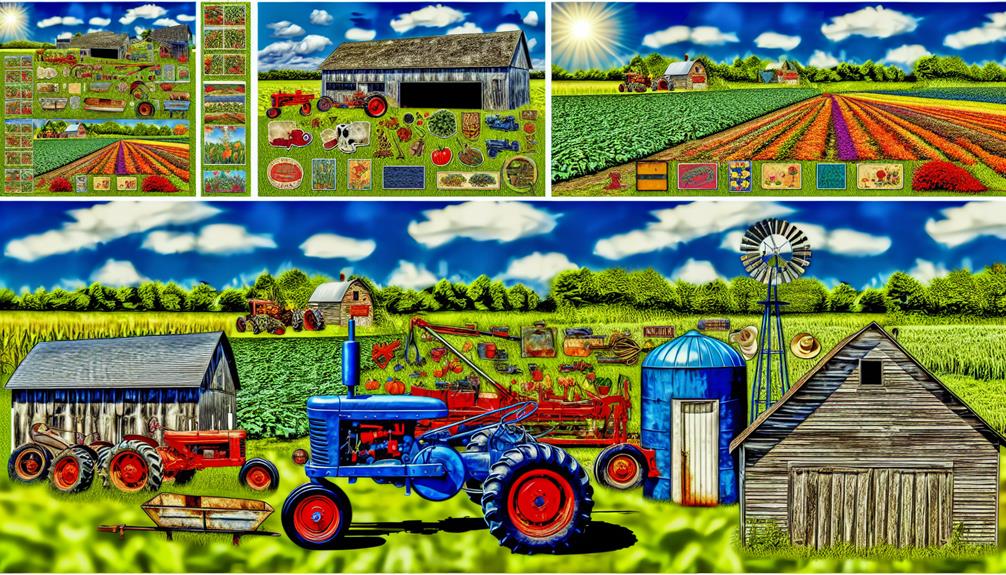
Customization options for your farm play a pivotal role in enhancing the gaming experience, allowing players to create a unique agricultural environment that reflects their personal style and strategy. From maximizing farm layout to selecting the right equipment and implementing effective soil management practices, each choice contributes to the overall success of the farming venture.
Players can explore aesthetic choices that align with their vision, such as seasonal themes that change with the in-game calendar. Crop diversity can be strategically managed, ensuring that players balance pest control and irrigation systems effectively. Additionally, building upgrades enhance functionality while reflecting individual preferences, fostering a sense of belonging within the farming community.
| Customization Aspect | Description |
|---|---|
| Farm Layout | Design the arrangement of fields and buildings for peak efficiency. |
| Equipment Selection | Choose machinery that best suits your farming style and crop types. |
| Crop Diversity | Cultivate a variety of crops to maximize yield and resilience. |
These options not only deepen engagement but also empower players to craft a farm that is truly their own, fostering a connection to the land and the community within the game.
The Best Tractors to Drive
When selecting the best tractors for your farming simulation experience, it is essential to contemplate top tractor brands that are renowned for their reliability and performance. Key features such as horsepower, fuel efficiency, and available attachments can greatly enhance your gameplay and productivity. Understanding these elements will help you make informed decisions that align with your farming goals.
Top Tractor Brands
The world of agriculture is heavily reliant on powerful machinery, and among these, tractors stand out as essential tools for modern farming. Various brands have established their reputation in the industry, each offering unique tractor technology, performance ratings, and a rich brand history. When considering the best tractors to drive, brand comparisons are vital, as they reflect the diverse needs of farmers today.
Here are three leading tractor brands known for their excellence:
- John Deere: Renowned for its innovative eco-friendly tractors, John Deere has a legacy of durability and efficiency.
- Case IH: This brand excels in offering advanced tractor accessories and maintenance solutions, ensuring peak performance for various farming tasks.
- Massey Ferguson: Known for their vintage models, Massey Ferguson combines tradition with modern technology, making them a favorite among farmers who value reliability.
Each brand has its strengths and caters to different farming requirements. Understanding the unique features and history of these brands can help farmers make informed decisions, ensuring they choose the right tractor for their agricultural endeavors.
Features to Consider
Selecting the right tractor involves careful consideration of several key features that can profoundly impact farming efficiency and productivity. With the rise of modern farming technology, it is essential to choose a tractor that aligns with sustainable practices and meets the specific needs of your farm.
When evaluating tractors, consider the following features:
| Feature | Importance | Impact on Farming |
|---|---|---|
| Engine Power | Determines the tractor's ability to handle various tasks | Higher power improves efficiency |
| Fuel Efficiency | Affects operational costs and sustainability | Reduces carbon footprint |
| Versatility | Ability to attach different implements | Increases the range of tasks |
Tips for New Players
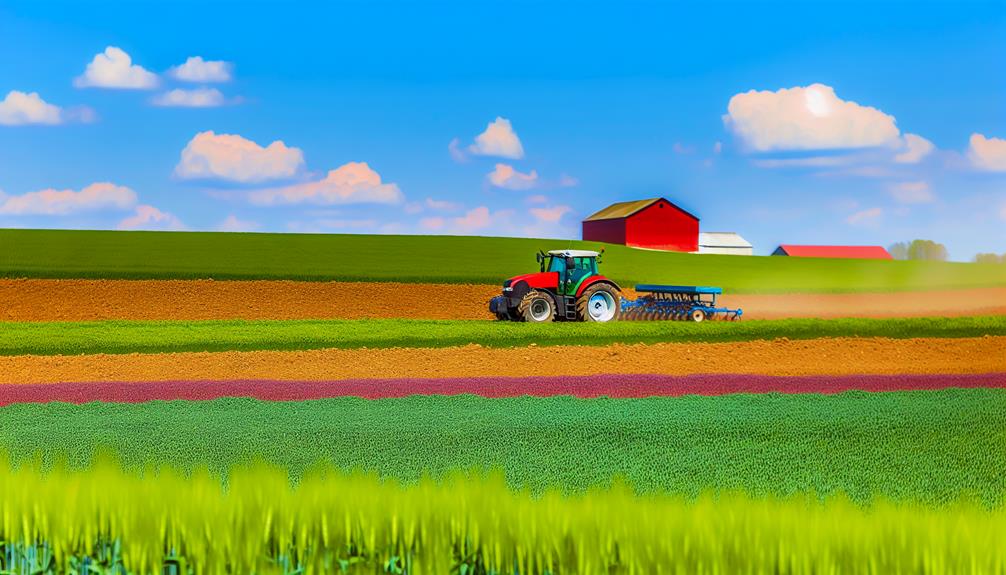
Although diving into the world of farming simulation games can initially seem overwhelming, new players can quickly acclimate by focusing on a few essential strategies. Understanding the basics is important to enhance your gaming experience and maximize your farm's productivity. Here are some valuable farming tips and beginner strategies to help you get started:
- Prioritize Resource Management: Efficiently manage your resources, including crops, livestock, and finances. This will guarantee your farm operates smoothly and sustainably.
- Learn the Map: Familiarize yourself with the game's terrain, including the best spots for planting and the locations of essential facilities. This knowledge is critical for strategic planning.
- Experiment and Adapt: Don't hesitate to try different crops and farming techniques. Adaptability is key in maneuvering the challenges of farming simulation.
The Future of Farming Games
As technology continues to evolve, the future of farming games is poised to become increasingly immersive and realistic. With advancements in technology integration, players can expect a deeper connection to sustainable agriculture practices, fostering environmental awareness and resource management skills. Virtual reality (VR) is set to revolutionize the gaming experience, allowing players to engage in farming activities that mirror real-world scenarios.
Future trends are likely to focus on educational benefits, enabling players to learn about farming innovation and modern agricultural techniques while playing. This approach not only enhances player engagement but also cultivates a sense of community impact, as gamers share knowledge and experiences that promote responsible farming practices.
Moreover, the incorporation of AI-driven algorithms will personalize gameplay, adapting challenges based on players' choices and promoting a dynamic farming environment. As these elements converge, the landscape of farming games will not only entertain but also empower players to make informed decisions about their agricultural practices. The future of farming games promises a blend of fun and learning, paving the way for a generation that values sustainability and community involvement in agriculture.
Frequently Asked Questions
Can I Play Farming Games on Mobile Devices?
Yes, you can play farming games on mobile devices, which have become increasingly popular in the gaming landscape. Numerous mobile gaming options cater to fans of the genre, offering a diverse selection of titles that enhance the farming experience. Popular titles include "Farming Simulator 20" and "Stardew Valley," both of which provide immersive gameplay and engaging mechanics. These games foster a sense of belonging within a community of players who share a passion for agriculture and simulation.
Are There Farming Games With Realistic Weather Effects?
Yes, there are farming games that incorporate realistic weather effects, enhancing the overall gameplay experience. These titles utilize advanced weather simulation technology to reflect dynamic climate impact, affecting crop growth, harvesting, and livestock management. Players can face challenges such as droughts or heavy rainfall, which require strategic planning and adaptation. Such features not only promote immersive gameplay but also foster a sense of community among players who appreciate the complexities of agriculture in varying environmental conditions.
How Do Farming Games Handle Seasons and Time Progression?
Farming games often incorporate seasonal challenges and time progression to create a realistic agricultural experience. Players must effectively manage time, adapting to changing seasons that influence crop growth, livestock care, and resource availability. This dynamic environment requires strategic planning to optimize yields and navigate the unique demands of each season. Such mechanics not only enhance gameplay realism but also foster a deeper connection to the agricultural lifestyle, appealing to enthusiasts seeking immersive engagement.
Can I Mod My Farming Game for Additional Content?
Yes, you can mod your farming game to add additional content, as many titles support modifications. Engaging with modding communities can enhance your experience by providing access to user-generated content, which often includes new vehicles, crops, and gameplay mechanics. These modifications not only enrich the gaming experience but also foster a sense of belonging among players who share their creativity and passion for the game, ultimately contributing to a vibrant gaming ecosystem.
Are There Farming Games Based on Real-Life Farming Practices?
Yes, several farming games are designed to reflect real-life farming practices, incorporating authentic agriculture techniques and crop management strategies. These games often simulate the complexities of modern farming, allowing players to engage with realistic scenarios involving soil health, pest control, and seasonal planting. By emphasizing sustainable practices and resource management, these simulations not only entertain but also educate players about the intricacies of agriculture, fostering a sense of community among enthusiasts who share a passion for farming.











